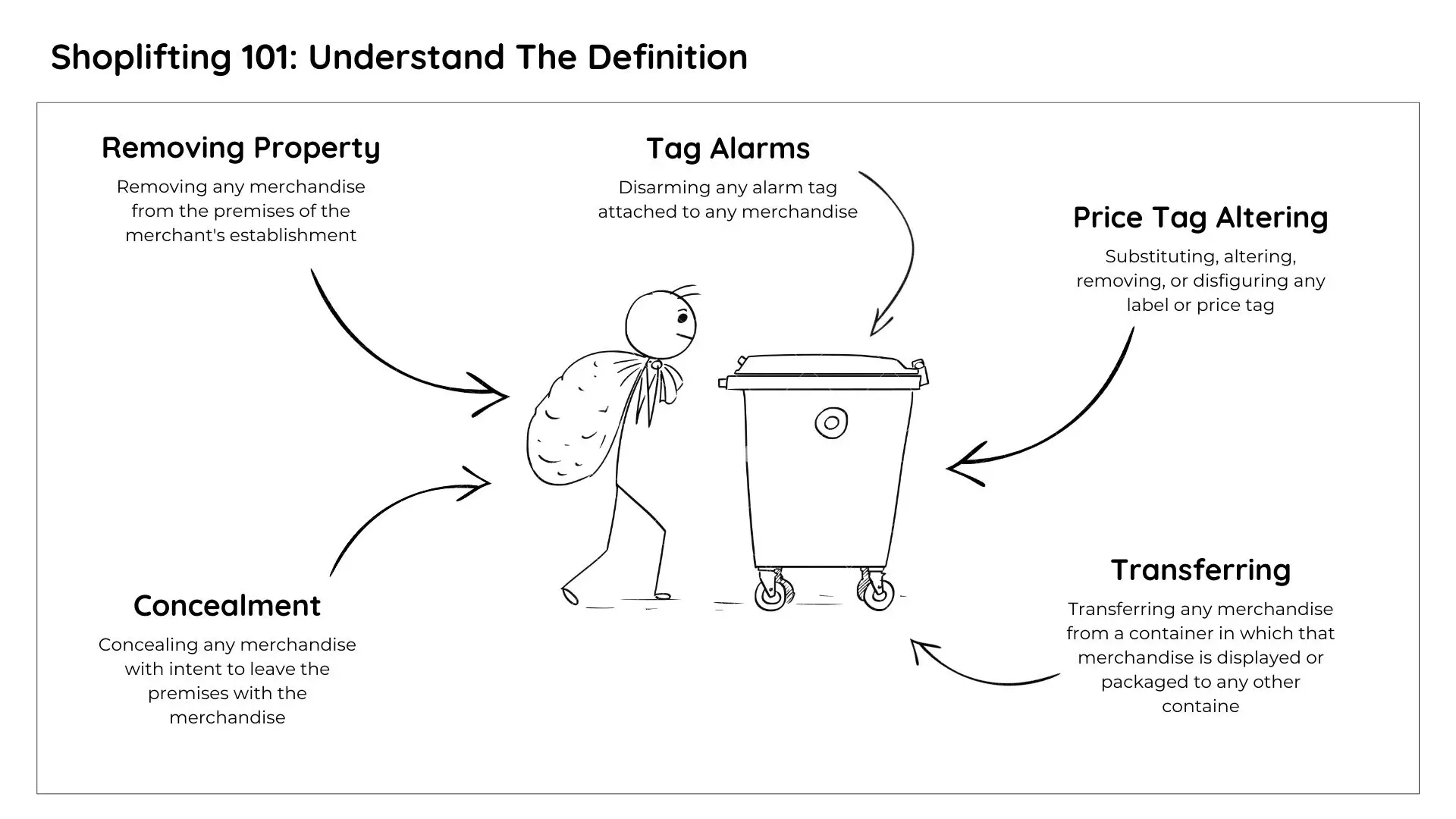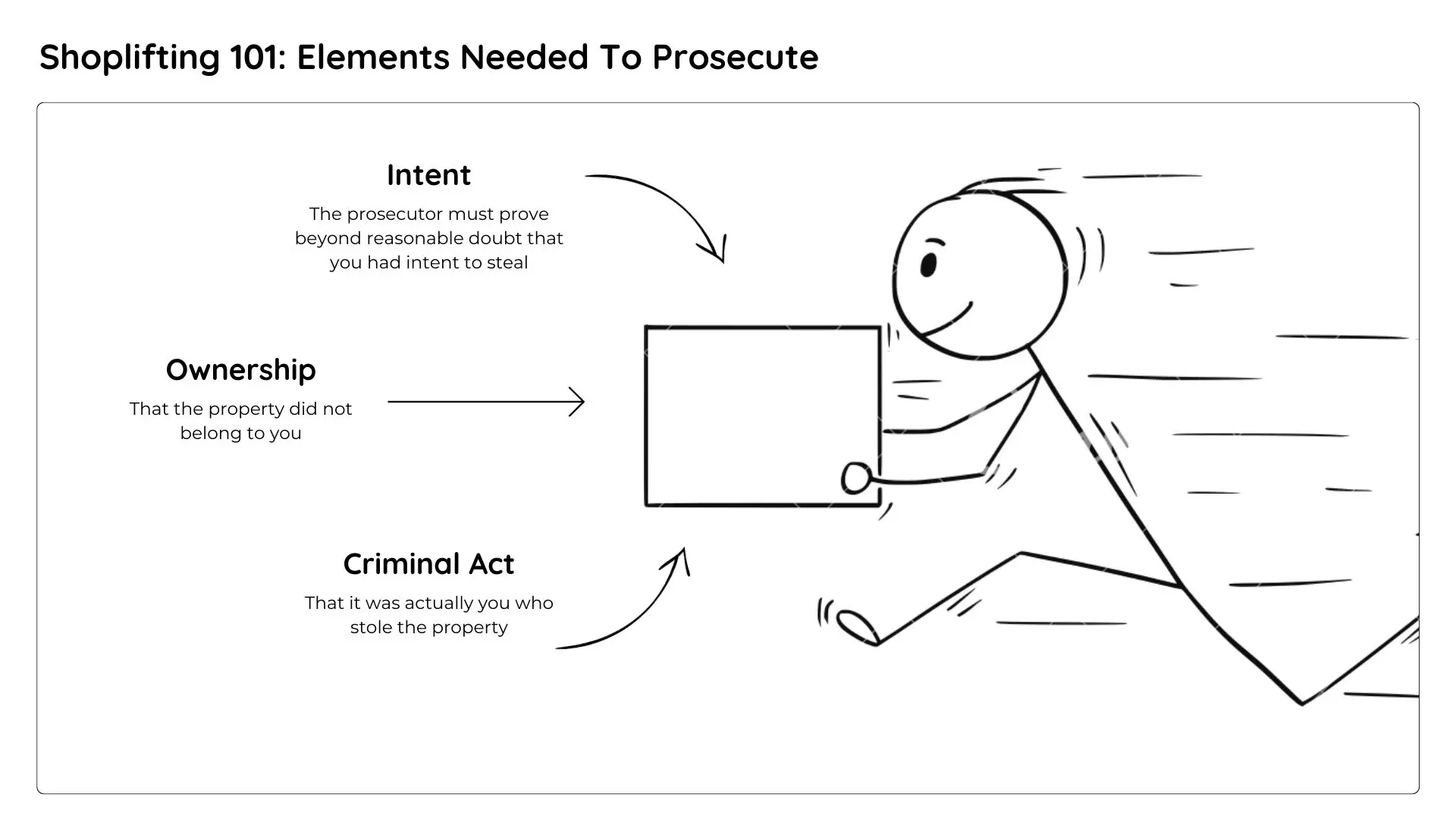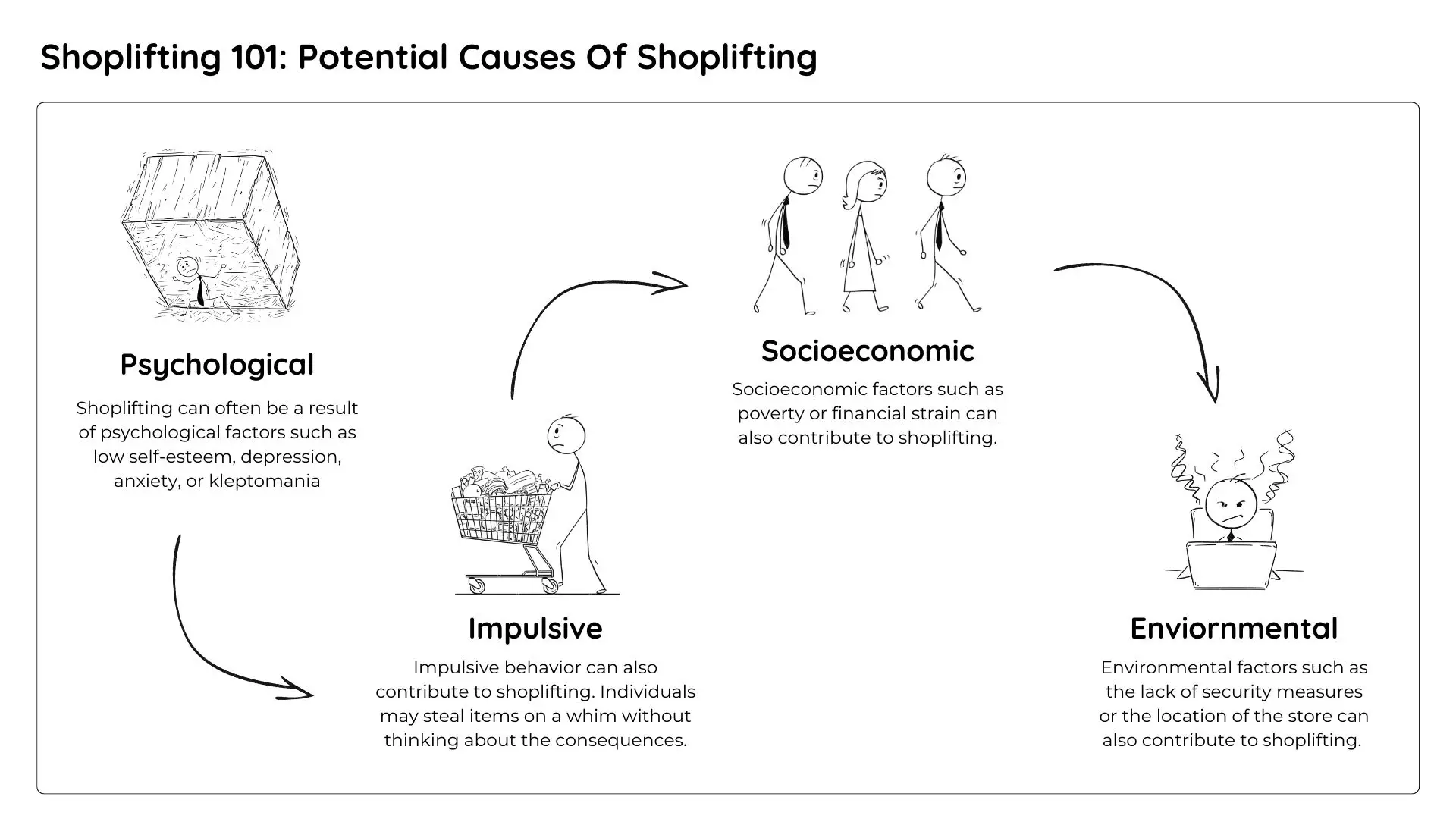Shoplifting is taking items such as clothes, electronics, food, and more from a store without paying. It’s illegal and can result in fines, arrest, imprisonment, and a criminal record. In 2021, over 548,000 instances of shoplifting were reported, accounting for nearly one-fifth of all reported theft and larceny crimes.
That’s just a quick summary. In this article, we will break down the definition, charges, and punishments for shoplifting. We’ll also be going to use the state of Kansas as the reference for charges and punishments in this article.
Shoplifting Definition
Now that you’ve been given a quick overview, let’s dig deeper into what shoplifting is. In Kansas shoplifting is a broader term put under the main crime of theft.

The definition of “shoplift” under (Kan. Stat. § 60-3331 (2020).) encompasses any one or more of the following acts, all of which are committed without the merchant’s consent and with the intention of taking merchandise for personal or third-party use without payment, obtaining merchandise at a price lower than its stated value, or otherwise depriving the merchant of all or part of the merchandise’s worth or use.
These acts include:
- Removing any merchandise from the premises of the merchant’s establishment;
- Concealing any merchandise with intent to leave the premises with the merchandise;
- Substituting, altering, removing, or disfiguring any label or price tag;
- Transferring any merchandise from a container in which that merchandise is displayed or packaged to any other container; or
- Disarming any alarm tag attached to any merchandise.
The different types of shoplifting can include Taking and Walking Out, Concealment, Booster Bags, Tag Switching, Group Shoplifting, and SweetHearting.
Elements Needed To Charge Shoplifting
Being charged with shoplifting does not automatically make someone guilty.

In the legal system, individuals are considered innocent until proven guilty. After being charged, the person will have the opportunity to present their defense and evidence in court, and it is up to the prosecution to prove their guilt beyond a reasonable doubt.
These elements are:
- The prosecutor must prove beyond reasonable doubt that you had intent to steal
- That the property did not belong to you
- That it was actually you who stole the property.
If the prosecution is unable to do so, the person will be acquitted and cleared of the charges. It is important to remember that everyone has the right to a fair trial and legal representation.
What Are The Penalties of Shoplifting
Given shoplifting falls under the category of theft in the state of Kansas, both criminal and civil penalties can be brought into your case.
Criminal Penalties
Shoplifting is considered theft under the law, and the severity of the penalty for a shoplifting offense depends on the value of the stolen merchandise.
A first-time offender who steals less than $1,500 worth of property will generally face a class A misdemeanor charge. However, a repeat offender or someone who shoplifts more valuable items, from multiple stores, or who uses tools like coated bags or alarm removers, or fraudulent receipts or labels, can face a severity level 9 felony charge under Kansas law (Kan. Stat. § 21-5805 (2020)).
Civil Penalties
Shoplifters not only face possible criminal penalties but can also be held civilly liable to the store owner.
If the merchandise is not returned in a sellable condition, the shoplifter may be liable for a civil penalty equal to twice the retail cost or $50, whichever is greater, up to a maximum of $500. If the merchandise is returned in a sellable condition, the shoplifter may be liable for a civil penalty of $50 or 50% of the retail cost, whichever is greater, up to a maximum of $350. If the shoplifter is a minor, the maximum penalty is $50.
Additionally, the shoplifter may also be responsible for the store owner’s reasonable attorneys’ fees and costs, unless the case remains in small claims court. In cases involving a minor, the minor’s parents are liable for any civil penalties under Kansas law (Kan. Stat. § 60-3331 (2020)).
Famous Shoplifting Cases
The “Bling Ring”: This group of young adults, who were based in Los Angeles, broke into the homes of several celebrities in the late 2000s and stole millions of dollars worth of jewelry, clothing, and other items. Their exploits were chronicled in a book and later turned into a movie.
The “Queen of Shoplifting”: Doris Payne is a notorious career criminal who is known for her decades-long career as a professional shoplifter. She has been arrested and convicted numerous times over the years for stealing high-end jewelry from stores around the world.
The “Diaper Bandit”: In 2015, a man was caught on surveillance camera stealing thousands of dollars worth of diapers from a New Hampshire store. He was eventually caught and charged with shoplifting, and the incident highlighted the growing problem of diaper theft across the country.
The “Candy Bar Bandit”: In 2019, a man in New Jersey was arrested for stealing thousands of dollars worth of candy bars from a local supermarket. He was caught on camera stuffing the candy into his jacket and then selling it online.
The “Beer Run”: In 2018, two men in Texas stole $1,000 worth of beer from a convenience store. They were caught and charged with theft, and the incident became infamous after a video of their getaway car crashing into a police car went viral.
Potential Causes Of Shoplifting
Now that we’ve explored different types of shoplifting we now we will explore the various factors that can lead individuals to engage in shoplifting. From psychological factors to environmental factors, it’s important to understand why shoplifting occurs.

By delving into the causes of shoplifting, we can better address and prevent this crime, and work towards creating a safer and more secure retail environment.
Psychological factors: Shoplifting can often be a result of psychological factors such as low self-esteem, depression, anxiety, or kleptomania. Kleptomania is a type of impulse control disorder that involves the repeated urge to steal, even when the person doesn’t need or can’t use the stolen items. This behavior is not motivated by material gain but rather a compulsive need to steal. People with kleptomania may feel a rush or high from stealing and may seek out opportunities to do so. This can lead to criminal charges, strained relationships, and other consequences. A person with kleptomania can be treated through therapy, medication, or a combination of both. For example, a person with kleptomania may feel compelled to steal makeup from a store even though they can afford to buy it, leading to repeated criminal behavior and increasing distress in their life.
Socioeconomic factors: Socioeconomic factors such as poverty or financial strain can also contribute to shoplifting. Individuals who are struggling to make ends meet may turn to shoplifting as a means of obtaining necessary goods. For example, someone who can’t afford to buy groceries for their family may steal food from a store.
Environmental factors: Environmental factors such as the lack of security measures or the location of the store can also contribute to shoplifting. Stores located in high-crime areas or with inadequate security measures may be more susceptible to shoplifting. For example, a store located in a high-crime area with no security cameras or loss prevention personnel may be more likely to experience shoplifting.
Impulsive behavior: Impulsive behavior can also contribute to shoplifting. Individuals may steal items on a whim without thinking about the consequences. For example, someone may see an item they want and impulsively decide to take it without paying for it.
By understanding the various causes of shoplifting, we can better address and prevent this crime
How to Reduce Shoplifting In Stores
If you’re a store owner you’re probably wondering how to legally reduce shoplifting in your stores.
Implement visible security measures: Retailers can implement visible security measures such as security cameras, security personnel, and electronic article surveillance systems to deter potential shoplifters.
Train employees: Train your employees to identify and report suspicious behavior, and to approach customers in a non-confrontational manner if they suspect shoplifting.
Improve store layout: Improve store layout by placing high-value items in areas that are highly visible and near checkout counters, and by reducing blind spots and areas with limited visibility.
Increase customer service: Increase customer service by greeting customers as they enter the store, engaging with them while they shop, and providing excellent service at checkout.
Use technology: Use technology such as RFID tagging and electronic article surveillance systems to track merchandise and detect shoplifting.
Work with law enforcement: Work with law enforcement by reporting incidents of shoplifting and providing video surveillance footage to aid in investigations.
By implementing these strategies, retailers can reduce the incidence of shoplifting in their stores and minimize losses due to theft.
When To Consult an Attorney
It is advised that you speak with a lawyer if you have been accused of shoplifting in order to safeguard your legal rights and have legal representation in court. A lawyer can assist you in comprehending the allegations made against you, the potential repercussions of a conviction, and your alternatives for mounting a defense.
Also, a lawyer could be able to argue for a reduced sentence or charges on your behalf. In addition, you should speak with a lawyer if you have been served with a civil lawsuit by a store owner or received a demand letter from their lawyer in order to fully understand your legal alternatives and rights in relation to the claim.
